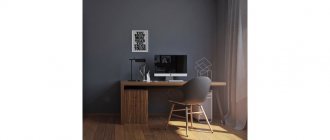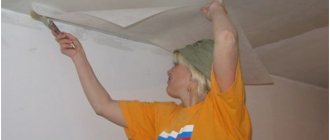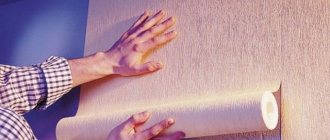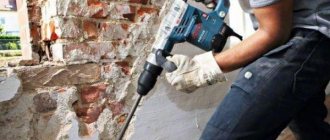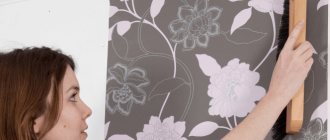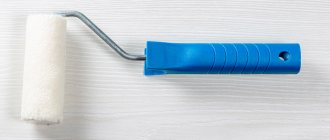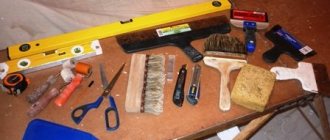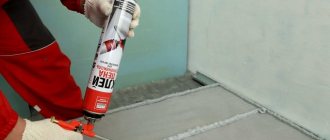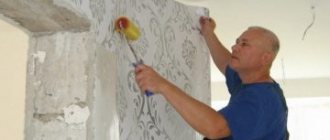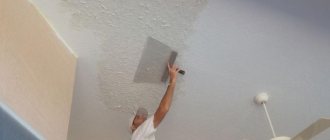What is fiberglass web used for? For what purpose is this material used in construction? First of all, as an additional protection of the finishing layer from cracks (microcracks) that form on surfaces. Of course, cracks don't always show up. But if you doubt the reliability of the surface, use fiberglass.
Painting fiberglass - what is it and why?
When the building shrinks or the plaster/putty dries, small cracks form on the walls and ceiling. They greatly spoil the appearance of painted surfaces. To prevent their formation when plastering, use a painting mesh. It reinforces finishing materials, preventing the formation of large cracks. Microcracks are combated with the help of painting fiberglass. This is a thin non-woven material made from many glass fibers of different thicknesses. The fibers are connected randomly to each other, which prevents cracks from appearing. There may be microcracks, but they are not visible. This determines the scope of application of painting fiberglass - to improve the quality of finishing of walls and ceilings.
To keep painted surfaces even and smooth, use a “cobweb”
The thickness of this material is small - it is translucent. Because of its appearance it received the name “cobweb”. Sold in rolls 1 meter wide, with different densities - from 20 g/m2 to 55 g/m2. The density is selected depending on the application. For interior work, 30-40 g/m2 is more often used.
Fiberglass is glued with glue for glass wallpaper onto more or less even walls. It successfully masks small cracks (up to 0.5 mm wide) and unevenness, creating a smooth surface. That’s why this technology is becoming more widespread - it simplifies the preparation of walls for painting (putty), and the result is no worse. The same material can be glued to drywall. It successfully masks joints and prevents the formation of cracks in these places. The main thing when gluing is to place the seams of fiberglass away from the joints of the gypsum board.
This is what a fiberglass web looks like
Painting fiberglass is inconvenient to work with - the fiberglass breaks, and its smallest particles can get into the lungs. Therefore, you need to work in protective clothing and, preferably, a respirator. After it is glued and hidden with several layers of finishing materials, there is no question of any migration of fiberglass. In this state it is absolutely harmless.
Why do we need personal protective equipment?
Fiberglass adhesive contains complex chemical compounds similar to PVA. Toxic fumes from covering walls with canvas can cause poisoning in workers and even cause hallucinations.
Since the work is carried out indoors, and there is no way to ventilate the room, you must wear a respirator.
Harmful fumes can negatively affect the outer shell of the eyes, in this regard, glasses are a necessary element of protection.
Fiberglass particles are hard, sharp “needles.” When cutting rolls and seams of fiberglass coating, there is a danger of sharp particles getting into the lungs. The respirator will not allow fiberglass needles to pass through.
If glass dust comes into contact with exposed areas of the body, it can cause irritation and burning on the skin. The work uniform must be such that harmful dust does not penetrate under it. At the end of work, work clothes should be washed thoroughly.
Methods of application
Glue the painting fiberglass onto smooth gypsum plaster or onto a layer of starting putty. According to the technology, after gluing, leveling is required with a thin layer of finishing putty (for stripping), then a primer, and then painting. With this sequence of work, paint consumption is minimal; for a good result, 2 layers of paint are enough. Despite the additional cost of putty, if you are using expensive paint, it is better to stick with this technique. This method is also used if the paint is glossy or semi-gloss.
There is another approach. The cobweb is glued and painted after drying. No puttying. The end result is a good result - a slightly structured surface with a slight “hairiness”. But it takes a lot of paint, and for a normal result you have to apply at least 4 layers. The first pass, the paint is absorbed very quickly, the consumption is 3-4 times more than normal. At the same time, the appearance of the wall is unsatisfactory: in some places there is not enough paint, in others - where we went over one place with a roller several times - there is a lot of it.
The second coat of paint takes almost half as much and looks a little better. Consumption continues to decrease, but not at the same rate. After 4 layers, the appearance of the wall is already normal, but the total amount of paint composition is impressive.
After gluing, it is advisable to cover the painting fiberglass with primer
To reduce paint consumption, after gluing, coat the painting fiberglass with a primer. Can be done in two layers. It will take a lot of primer, but much less paint. Moreover, even the first layer will lie well. For a good result, you will need 2-3 layers, but with normal consumption. So this method is also not bad, but it can be used with matte or semi-matte paint.
Disadvantages of glass wallpaper
It would be completely wrong to talk only about the advantages of glass wallpaper. After all, this material has its own application features and disadvantages that limit the possibility of use in specific conditions. The disadvantages of glass wallpaper include:
- Lack of flexibility. The material does not withstand bending loads well. In particular, if you glue canvases to curved walls with large depressions and defects, the result may be the appearance of cracks and loss of presentability. In view of this, glass wallpaper should be used exclusively on leveled substrates with a small number of defects.
- Porosity. The presence of a porous structure is both an advantage and a disadvantage of glass wallpaper. On the one hand, this property allows the walls to “breathe”, but on the other hand, it increases paint consumption. The applied paint penetrates well into the porous structure, due to which the first painting requires the use of copious amounts of paint and varnish. This, in turn, results in additional budget expenditure.
- Heavy weight. Fiberglass wallpaper itself is heavy, which can negatively affect the quality of use. The mass of the material is also increased by a layer of paint and glue used to fix the paintings on the walls. Together they create a large load on the base. For this reason, glass wallpaper is not suitable for loose substrates, inclined surfaces and ceilings. For the same reason, it is not recommended to repaint glass wallpaper many times.
- Difficult to dismantle. After gluing and drying the glue, sometimes you have to tear off the glass wallpaper, as they say “alive” - along with the plaster.
- Loss of decorative effect when re-painted. Textured glass wallpaper has a slightly pronounced relief. Each subsequent painting will lead to a deterioration in the visual effect of the decor.
- High price. Fiberglass wallpaper itself is an expensive product. Along with the need for a large consumption of paint, carrying out repairs with such material can cost a pretty penny.
Bonding technology
Painting fiberglass canvas is glued to glass wallpaper adhesive. It is important that the glue is good, but it does not have to be expensive. The gluing technology is very similar to wallpapering:
- The glue is applied to the wall or ceiling with a roller or brush. The glue layer is thick, but it needs to be distributed evenly.
- A cobweb is rolled out onto the greased wall, it is well saturated with glue and lays down easily. The canvas must be straightened evenly, without folds or “accordions”.
- Use a plastic spatula or a large stainless steel spatula to remove air bubbles. It’s easier to do this by moving it from the middle to the edges.
- Again, take a roller or brush and apply glue on top of the fiberglass.
- Using a spatula, rub the glue, filling the pores. If there is not enough glue, add more, the excess remains on the spatula.
- The second canvas is glued overlapping with the first. The canvas extends about 2 cm. The sequence is the same: apply glue to the wall, roll out the canvas, and push out the bubbles. Then we take a ruler or a large spatula, a stationery knife with a sharp blade. We apply a ruler/spatula to the junction of the two canvases, cut through both canvases.
The main thing is to make the junction of the two canvases invisible
You shouldn't press too hard - you can scratch the putty and there will be a groove left that will be visible. The task is to cut through both sheets, but not to cut the putty. It's easier to do this with a sharp knife. We remove the excess strips, coat the wall under the joint with additional glue (with a brush), connect and press with a spatula.
- Apply glue on top of the second canvas and fill the pores with a spatula.
- Glue the next strip.
As you can see, nothing complicated. Only all operations must be carried out carefully, achieving the best result that you are capable of.
There are several nuances regarding working conditions. There should be no drafts in the room, the temperature should not be lower than +15°C, humidity should be within normal limits. Keep doors and windows closed until the glue dries. If the sun is hot, it is better to curtain the windows. That's all, actually.
Source
Painting fiberglass web: application
Progress does not stand still, and every time we hear about something new in a variety of fields and industries.
Relatively recently, a new type of wall covering has appeared on the market - fiberglass. This type of coating is usually called cobweb glass wallpaper because of its appearance. Painting fiberglass web finds its application in reinforcing surfaces before finishing work. This material is not a finishing type coating, it is, so to speak, the basis for further finishing of walls and ceilings. The cobweb can be called an effective assistant in the fight against such serious problems as cracks on the surface of ceilings and walls.
Quite often, problems with cracks arise in new houses that were built relatively recently, because over time the house shrinks; painting fiberglass web, the use of which is appropriate in this case, is the best assistant in this situation.
It should also be noted that this type of finishing coating for walls today is gaining popularity in the market of finishing materials, and with quite serious momentum. The type of “preparatory wallpaper” in question has similarities and differences with glass wallpaper. We will also compare the manufacturing process of paper and fiberglass.
Technical characteristics and scope of material
Painting fiberglass canvas consists of fiberglass threads, like glass wallpaper, but the difference is that the web is not made on machines. The manufacturing process of the “wallpaper” in question is as follows: fiberglass comes under a press, as in the process of manufacturing sheets of paper. The result of such pressing is smooth, thin sheets, the surface of which is very smooth. The density of compressed fiberglass is 25-50 g/m2.
Although the process of making fiberglass webs and paper are to some extent similar, the difference between them is colossal - unlike paper sheets, they do not accumulate statistical electricity on their surface, and they are also not afraid of water, mechanical damage, or chemical reagents. Dust is also not attracted to them and, among other things, they do not burn. It is difficult for some to imagine what such a finishing material looks like, therefore, you can watch a video showing how to use fiberglass for painting in this article.
Similar characteristics of cobwebs and paper include their composition, namely, the ingredients included in its composition are exclusively natural, as in paper, they are also a non-allergenic material, and they allow air to pass through perfectly. The difference between fiberglass and glass wallpaper is the absence of a wicker pattern and relief on the surface of the former. But this also has its advantages, if there are no prominent elements on the surface, it means they can be painted an unlimited number of times, no relief - no problem.
How to properly glue painting fiberglass
In order to stick the material on the walls or ceiling, you do not need to have any special skills or knowledge. You just have to find out how it's done and get to work. If you don’t want to pay a lot of money to craftsmen for a fairly simple finishing process, then just follow the recommendations that will help you do everything correctly and quickly.
How to glue fiberglass webs with putty onto drywall video
- When the sheet is firmly attached to the wall, you can start cutting off all the excess that sticks out or hangs. Then apply glue to the surface again. To understand that the sheet is well soaked, it should become dark from moisture.
- We glue the next sheet, the same size as the previous one, to the wall, making sure to overlap. If the material is glued to the ceiling, then it is better to glue it along the room.
Glue consumption per 1m2
The question of glue consumption when finishing walls or ceilings with fiberglass paints arises quite often, because such a process will require a lot of it.
The fact is that there are no standards in this regard. It is impossible to accurately calculate the amount of glue that will be used per square meter of surface, because it will depend on who will apply this glue to the surface. If there is little glue, you will see it yourself; if there is too much glue, it will also be difficult not to notice. In order to sufficiently saturate the surface with glue, you must monitor the color of the fiberglass web; as soon as it darkens from moisture, there is a sufficient amount of glue on its surface.
- After we have glued the second sheet with an overlap, we saturate it with a layer of glue and, without fail, press it well against the wall. In order for the seams between the sheets to be invisible, you need to cut a strip through both glued layers, even if your cut turns out to be uneven, there is nothing wrong with that, we strive to ensure that the surface is smooth, and these unevenness of the strip you cut will not be visible on wall or ceiling.
- After 24 hours, the glue on the surface will dry completely, and you can proceed to the next stage of finishing.
Popular manufacturers
Some brands of adhesives for gluing fiberglass have earned special trust from users. Here are the main ones:
- Bostik (Bostik). It occupies a leading position and has an optimal price-quality ratio. It is best to use glue in dry rooms. You can glue not only fiberglass, but also vinyl and non-woven wallpaper onto it.
- Kleo (Kleo) Ultra. Created specifically for glass fibers, it is characterized by the highest quality, durability, ease of dilution, low consumption, and environmental friendliness.
- Wellton (Wellton). Ideal for subsequent coloring of fiberglass, equipped with additives to enhance fire safety, environmentally friendly. Fiberglass can be washed regularly - the glue is not afraid of moisture.
- Oscar (Oscar). Very economical glue - 0.5 kg of it is diluted with 10 liters of water. The product is easy to prepare and does not form lumps. The finished solution is stored for almost 2 months without loss of properties. Consumption is economical - only 250 g per square meter of area.
- Quelyd (Kelid). The product can be applied manually or by machine, it dries completely in just a day, and is stirred without lumps.
- Pufas (Pufas). This is a popular brand that creates building materials using new technologies. The brand's assortment includes many wallpaper adhesives, including fiberglass ones. The products are frost-resistant and contain fungicides.
- Bolars Fiberfix (5 kg). This glue is designed specifically for fiberglass, is sold in finished form, dries quickly, and can significantly reduce repair time.
Some users glue the edges and joints of fiberglass with sealants and liquid nails (for example, Obi, Moment). This is not at all necessary; high-quality glue for fiberglass materials will cope with any joints, reliably protecting them from detachment.
Painting fiberglass web application: how to paint
If you decide to paint the canvas, then we recommend using water-based paint for such a surface. Such paint will retain the properties of the finishing material itself and, moreover, more than one layer of paint can be laid on it in an even layer.
Using painting fiberglass, how to paint correctly video
For painting you will need the following tools:
- a tray where the paint will be poured;
- a roller, preferably with a thread-type pile (you can use a paint brush, but then the painting process will take a long time).
It is necessary to paint the fiberglass spider web twice, that is, apply two layers of paint. It is worth noting that the time between applying layers should be at least 12 hours. To roll a seam, you need to use a “wing”; if you do it with a roller, the result will not be optimal. In principle, these are all the features of painting such a finishing material.
Tool
In order to achieve a good result, it is important not only to choose the right coating material, but also to choose the right working tool. Depending on the depth of the pattern on the pasted wallpaper, it is necessary to use rollers with different pile lengths
In addition, other dyeing equipment may be required. The list of basic working equipment for painting ceilings looks like this:
- Rollers of different sizes and with different lengths of pile (depending on the depth of the pattern on the wallpaper).
- Brushes of different widths. They are useful when painting hard-to-reach areas and stripes along walls or corners.
- Paint sprayer. This is a difficult tool to use and should only be used when you are confident in your abilities and have some experience in handling such a device. If you have no experience, it is better to prefer a roller.
Do I need to putty on fiberglass paint before painting?
A positive quality of the web is that after gluing it to the wall, you can immediately begin painting the surface of the walls or ceiling. In this case, the word immediately means. After the surface has completely dried, simply without preliminary or preparatory work.
Fiberglass web application on the ceiling video
It is necessary to putty only if you want to have a completely flat surface of the wall or ceiling or if you want to hide the texture of the finishing material, in this case - cobwebs.
The best option for preparatory work before gluing would be to prime the fiberglass with glue, thereby reducing paint consumption. This is correct and profitable, because glue is much cheaper than paint.
Types of adhesive mixtures
Not every adhesive can be used to glue fiberglass; the solution requires high strength and a high degree of adhesion. It is optimal to use adhesives designed for glass fabrics, glass wallpaper and fiberglass. The product is available in the form of a ready-made solution or dry powder. Both products serve their purpose by providing good grip on the surface.
There are fiberglass sheets with an adhesive base; they are moistened with water before gluing.
Not every adhesive can be used to glue fiberglass; the solution requires high strength and a high degree of adhesion.
Ready-made adhesives
Gluing fiberglass is very simple, because you do not need to prepare a solution. Most often, polyvinyl acetate or polyacrylic is used in the composition; drying occurs after the water evaporates. The popular glue for spider webs is acrylic, due to its low consumption; applying a thin layer is sufficient. The adhesion will be excellent.
Special adhesives in the composition are also supplemented with other elements: plasticizers, polyvinyl alcohol, colloidal additives, they allow you to obtain a more reliable bond without delamination. Antifungal elements can also be used.
The popular glue for spider webs is acrylic, due to its low consumption; applying a thin layer is sufficient.
Dry powder
Pasting walls with fiberglass can also be done with dry powders. Before use, they are diluted with water; the ratio is always written on the packaging.
Components of the powder:
- Modified starch;
- Methylcellulose;
- Dry PVA;
- Technological elements.
Re-wetting is unacceptable, so you should not choose to paint the surface with water-based paint products.
It is also undesirable to paste the material in rooms with high humidity. Although there are compositions with additives that improve moisture resistance.
Before use, they are diluted with water; the ratio is always written on the packaging.
